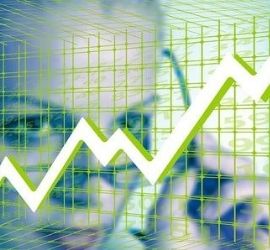What Is the Sustainable Growth Rate (SGR)?
 The sustainable growth rate (SGR) is the maximum rate of growth that a company can sustain without having to issue additional equity or take on new debt. The SGR involves maximizing sales and revenue growth without increasing financial leverage. Achieving the SGR can help a company to grow without being over-leveraged and avoiding financial distress.
The sustainable growth rate (SGR) is the maximum rate of growth that a company can sustain without having to issue additional equity or take on new debt. The SGR involves maximizing sales and revenue growth without increasing financial leverage. Achieving the SGR can help a company to grow without being over-leveraged and avoiding financial distress.
The sustainable growth rate is an indicator of what stage a company is in, during its life cycle. Understanding a company’s life cycle position can help determine corporate finance objectives. Issues such as which sources of financing to use, dividend payout policies, and overall competitive strategy.
The sustainable growth rate can also be used by creditors. It can help determine the likelihood of a company defaulting on its loans. A high growth rate may indicate the company is focusing on investment and expansion. However, this investment may delay the repayment of debt. A high-growth-rate company is generally considered riskier. In general, it likely sees greater earnings volatility from period to period.
Companies with high SGRs are usually effective in maximizing their sales efforts. They focus on high-margin products and manage inventory, accounts payable, and accounts receivable. However, maintaining a high sustainable growth rate in the long-term can prove difficult for companies for several reasons:
- Competition entering the market can erode margins and market share.
- Economic cycles and changes in economic conditions.
- Sustained Growth requires new products and the need to increase research and development.
Sustainable Growth Rate Formula #1
Sustainable Growth Rate = Return on Equity x (1 – Dividend Payout Ratio)
Return on Equity: (Net Income / Total Shareholder’s Equity). This represents how much return investors have realized relative to the profit the company has generated. ROE measures the profitability of a company by comparing net income to the company’s shareholders’ equity.
Dividend Payout Ratio: Subtract the company’s dividend payout ratio from 1. The dividend payout ratio is the percentage of earnings per share paid to shareholders as dividends. Finally, multiply the difference by the ROE of the company.
Sustainable Growth Rate Formula #2
The sustainable growth rate can also be calculated by multiplying the company’s earnings retention rate by its return on equity:
Sustainable Growth Rate = Retention Rate x Return on Equity
Retention Rate: [ (Net Income – Dividends) / Net Income) ]. This represents the percentage of earnings that the company has not paid out in dividends. In other words, how much profit the company retains, where Net Income – Dividends is equal to Retained Earnings.
Return on Equity: (Net Income / Total Shareholder’s Equity). This represents how much return investors have realized relative to the profit the company has generated.
A very high growth rate signifies that a company is still growing very quickly. As such, the company may be spending a lot of its earnings on research and development and may not have a lot of cash left over to make debt payments. Therefore, a growing company could benefit more from equity financing and issuing stock to finance its operations. Another reason why issuing equity may be a good idea for growing businesses is that growing companies are in a better position to compensate equity investors. Stockholders seek capital gains, meaning that the company does not have to make costly periodic cash payments. It can instead channel funds to business development. (Source:corporatefinanceinstitute)
What the SGR Can Tell You
For a company to operate above its SGR, it needs to maximize sales efforts and focus on high-margin products and services. Also, inventory management is important. Management must have an understanding of the ongoing inventory needed to match and sustain the company’s sales level.
The Sustainable Growth Rate of a company can help identify whether it’s managing day-to-day operations properly. This includes basic things like paying its bills and its payroll on time. Managing accounts payable also needs to be managed in a timely manner to keep cash flow running smoothly.
Accounts Receivable Management
Managing the collection of accounts receivable is also critical to maintaining cash flow and profit margins. Accounts receivable represents money owed by customers to the company. The longer it takes a company to collect its receivables contributes to a higher likelihood that it might have cash flow shortfalls and struggle to fund its operations properly. As a result, the company needs to incur additional debt or equity to make up for this cash flow shortfall. Companies with low SGR might not be managing their payables and receivables effectively. (Source:investopedia)
A High Sustainable Growth Rate is Difficult to Maintain
Sustaining a high SGR in the long term is difficult for most companies. As revenue increases, a company tends to reach a sales saturation point with its products. As a result, to maintain the growth rate, companies need to expand into new or other products. These products might have lower profit margins or require research and development. The lower margins could decrease profitability and strain financial resources. Research and development can also become a financial drain. Either case can potentially lead to a need for new financing to sustain growth. On the other hand, companies that fail to attain their SGR risk stagnation and decline.
Pursuing a high sustainable growth rate assumes that a company wants to maintain a target capital structure. This means stable debt and equity and maintaining a static dividend payout ratio. However, there is a need to accelerate sales as quickly as the organization allows. There are cases when a company’s growth becomes greater than what it can self-fund. In these cases, the firm must adopt a financial strategy that raises the capital needed to fund its rapid growth. The company can issue equity and increase financial leverage through debt. It can also reduce dividend payouts or increase profit margins by maximizing the efficiency of its revenue. All of these methods are tools that can be used to increase the company’s SGR.
Sustainable Growth Rate vs the PEG Ratio
The Sustainable Growth Rate is a metric that evaluates viable growth as it relates to debt and equity. The PEG ratio is a valuation metric used to determine if the stock price is undervalued or overvalued.
- The Price-to-earnings-growth ratio (PEG ratio) is a stock’s price-to-earnings (P/E) ratio divided by the growth rate of its earnings for a specified time period. The PEG ratio is used to determine a stock’s value while taking the company’s earnings growth into account. The PEG ratio is said to provide a more complete picture than the P/E ratio.
- The Sustainable Growth Rate involves the growth rate of a company without taking into account the company’s stock price. However, the PEG ratio calculates growth as it relates to the stock price. As a result,
Sustainable Growth Rate Limitations
Achieving a high SGR is every company’s goal. But there are speed bumps that can stop a business from growing and achieving its SGR.
- Consumer trends and economic conditions can help a business achieve its sustainable growth or cause the firm to miss it completely. Consumers with less disposable income are traditionally more conservative with spending, making them discriminating buyers. Companies compete for the business of these customers by slashing prices and potentially hindering growth.
- Product development costs – Companies also invest money into new product development to try to maintain existing customers and grow market share, which can cut into a company’s ability to grow and achieve its SGR.
- Poor planning and forecasting – A company’s forecasting and business planning can detract from its ability to achieve sustainable growth in the long-term. Companies sometimes confuse their growth strategy with growth capability and miscalculate their optimal SGR. If long-term planning is poor, a company might achieve high growth in the short-term but won’t sustain it in the long-term.
- Reinvestment – In the long-term, companies need to reinvest in themselves through the purchase of fixed assets, which are property, plant, and equipment (PP&E). As a result, the company may need financing to fund its long-term growth through investment. Capital-intensive industries like oil and gas need to use a combination of debt and equity financing in order to keep operating since their equipment such as oil drilling machines and oil rigs is so expensive. It’s important to compare a company’s SGR with similar companies in its industry to achieve a fair comparison and meaningful benchmark.
SGR Calculation Example
Suppose a company has an ROE of 16% and a dividend payout ratio of 50%. You would calculate its SGR as follows:
Sustainable Growth Rate = Return on Equity x (1 – Dividend Payout Ratio)
SGR = (ROE: .16) x (1-0.50 Dividend Payout Ratio) = 0.08 or 8%
This means that the company can safely grow at a rate of 8% using its current resources and revenue. This is without incurring additional debt or issuing equity to fund growth.
If the company wants to accelerate its growth past the 8% threshold to, say, 12%, the company would likely need additional financing. The sustainable growth rate assumes that the company’s sales revenue, expenses, payables, and receivables are all being managed to maximize effectiveness and efficiency.
SGR for Walmart
Consider the retail giant Walmart (WMT); here are its financial details as Aug. 19, 2020:
ROE: 21.3%, Dividend Payout Ratio: 40.3%, SGR Calculation: 0.213 * (1 – 0.403)
Based on the SGR formula results, the company can grow at a sustainable rate of 12.7% without having to issue additional equity or take on additional debt. (Source:ibid)
The Challenge of Attaining Sustainable Growth
Sustainable growth is a key concern for small business owners and big corporate executives alike. Obviously, achieving this goal is no easy task. There is influence by rapidly changing political, economic, competitive, and consumer trends. Each of these trends presents unique challenges to business leaders in seeking to maintain growth. For example, customer expectations are changing considerably. Modern consumers have less disposable wealth than their parents. As a result, this makes them more discriminating buyers. Similarly, competition is fierce in nearly all industries. There are unprecedented breakdowns in the barriers that formerly separated global competitors. In response, companies must try to attract customers by redefining value. Also, they must keep those same customers by beating their competitors and delivering value.
The growth challenge is articulated differently by different companies and within different industries. For some, developing and launching new products and services to meet the evolving needs of their customers is the issue. For others, capitalizing on global opportunities is key. Some companies look to new business areas that will represent the next major thrust for their business. A few companies use all of these strategic efforts simultaneously. Economists and business researchers contend that achieving sustainable growth is not possible without paying heed to twin cornerstones: growth strategy and growth capability. Companies that pay inadequate attention to one aspect or the other are doomed to failure in their efforts to establish practices of sustainable growth. After all, if a company has an excellent growth strategy in place, but has not put the necessary infrastructure in place to execute that strategy, long-term growth is impossible. (Source:inc.com)
Up Next: What is Corporate Development?
Corporate Development is the internal focus of a corporation to generate and weigh strategic decisions to grow and restructure the business. Often this development is through establishing strategic partnerships, mergers, acquisitions, and joint ventures. The purpose is to create opportunities for the company through actions and deals that leverage the value of the company’s business proposition. Corporate development is needed to create and execute innovative strategies that will help the company establish and maintain its competitive advantage. The goal is to improve the financial and operating performance of the company. Also, to enable the company to outperform its competitors.



